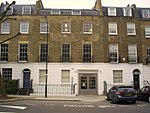The Vaughan Williams Memorial Library (VWML) is the library and archive of the English Folk Dance and Song Society (EFDSS), located in the society's London headquarters, Cecil Sharp House. It is a multi-media library comprising books, periodicals, audio-visual materials, photographic images and sound recordings, as well as manuscripts, field notes, transcriptions etc. of a number of collectors of folk music and dance traditions in the British Isles. According to A Dictionary of English Folklore, "... by a gradual process of professionalization the VWML has become the most important concentration of material on traditional song, dance, and music in the country." It is named after Ralph Vaughan Williams, the composer, collector and past president of the EFDSS, who died in 1958.
Prior to that it was known as the Cecil Sharp Library, since his books constituted the bulk of the original holdings, but over the years the library has added literature, sound and manuscript collections of other folklorists and collectors such as Lucy Broadwood, Janet Blunt, Anne Gilchrist, George Butterworth, the Hammond brothers and George Gardiner. It also contains copies of the papers and notebooks of Sabine Baring-Gould, Ralph Vaughan Williams, Alfred Williams and James Madison Carpenter; and the field recordings of Percy Grainger, Mike Yates and the BBC Folk Music Archive.
Subjects covered include: Folk/traditional/popular song, Child Ballads, Broadside ballads, Industrial/occupational songs, sea songs/shanties, singing games, Nursery rhymes, Street cries, Carols/hymns, Rounds/glees/part songs, Music hall, Ritual/ceremonial dance, Morris dance/sword dance and a great deal more.











